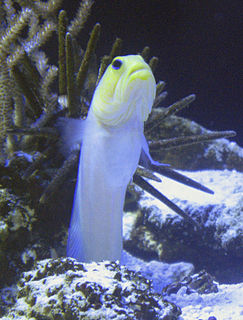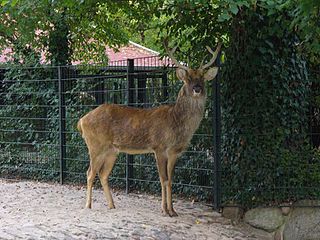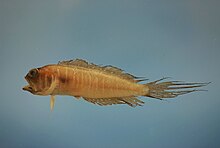Genus is a taxonomic rank used in the biological classification of living and fossil organisms as well as viruses, in biology. In the hierarchy of biological classification, genus comes above species and below family. In binomial nomenclature, the genus name forms the first part of the binomial species name for each species within the genus.

Vespertilionidae is a family of microbats, of the order Chiroptera, flying, insect-eating mammals variously described as the common, vesper, or simple nosed bats. The vespertilionid family is the most diverse and widely distributed of bat families, specialised in many forms to occupy a range of habitats and ecological circumstances, and it is frequently observed or the subject of research. The facial features of the species are often simple, as they mainly rely on vocally emitted echolocation. The tails of the species are enclosed by the lower flight membranes between the legs. Over 300 species are distributed all over the world, on every continent except Antarctica. It owes its name to the genus Vespertilio, which takes its name from a word for bat, vespertilio, derived from the Latin term vesper meaning 'evening'; they are termed as evening bats and once referred to as 'evening birds'.

Bulbophyllum is a genus of mostly epiphytic and lithophytic orchids in the family Orchidaceae. It is the largest genus in the orchid family and one of the largest genera of flowering plants with more than 2,000 species, exceeded in number only by Astragalus. These orchids are found in diverse habitats throughout most of the warmer parts of the world including Africa, southern Asia, Latin America, the West Indies, and various islands in the Indian and Pacific Oceans. Orchids in this genus have thread-like or fibrous roots that creep over the surface of trees or rocks or hang from branches. The stem is divided into a rhizome and a pseudobulb, a feature that distinguished this genus from Dendrobium. There is usually only a single leaf at the top of the pseudobulb and from one to many flowers are arranged along an unbranched flowering stem that arises from the base of the pseudobulb. Several attempts have been made to separate Bulbophyllum into smaller genera, but most have not been accepted by the World Checklist of Selected Plant Families.

The Atlantic goliath grouper or itajara, also known as the jewfish, is a large saltwater fish of the grouper family found primarily in shallow tropical waters among coral and artificial reefs at depths from 5 to 50 m. On the Western side, its range includes the Florida Keys in the US, the Bahamas, most of the Caribbean and most of the Brazilian coast. On some occasions, it is caught off the coasts of the US states of New England off Maine and Massachusetts. In the eastern Atlantic Ocean, it occurs from the Congo to Senegal.

Achille Valenciennes was a French zoologist.

Sphaerites is a genus of beetles, the only genus in the family Sphaeritidae, sometimes called the false clown beetles. It is closely related to the clown beetles but with distinct characteristics. There are five known species, widespread in temperate area but not commonly seen.

The yellowhead jawfish is a species of jawfish native to coral reefs in the Caribbean Sea. It is found at depths of from 3 to 40 metres. The head and upper body are a light, but brilliant, yellow color slowly fading to a pearlescent blue hue. It can reach a length of 10 centimetres (3.9 in) TL. Yellowhead jawfishes are usually found in Florida. They are usually found in shallow areas where materials are available for burrow construction. The Jawfishes live in rubble areas and sand in groups of up to 70 species.

Opistognathidae, the jawfishes, are a family of fishes which have been classified within the order Perciformes, suborder Percoidei but many authorities now classify this family within the clade Ovalentaria and consider that its affinities within that clade are uncertain, i.e. it is incertae sedis. The family includes about 80 species. They are native to warmer parts of the Atlantic, Pacific and Indian Oceans, where found from the shallows to depths of a few hundred meters. The species level taxonomy is complex and the family includes several undescribed species.

Habenaria, commonly called rein orchids or bog orchids, is a widely distributed genus of orchids in the tribe Orchideae. About 880 species of Habenaria have been formally described. They are native to every continent except Antarctica, growing in both tropical and subtropical zones.

In biological classification, taxonomic rank is the relative level of a group of organisms in a taxonomic hierarchy. Examples of taxonomic ranks are species, genus, family, order, class, phylum, kingdom, domain, etc.
The dusky jawfish is a species of jawfish native to the western Atlantic Ocean including the Gulf of Mexico and the Caribbean Sea where it is an inhabitant of reefs at depths of from 1 to 12 metres. It can reach a length of 14 centimetres (5.5 in) TL. This species can also be found in the aquarium trade. The specific name honours Dr. D. D. Whitehurst, a collector of specimens for the Smithsonian Institution, one of which was the type specimen of this species.

The blue-spotted jawfish is a species of jawfish native to the Gulf of California. It is an inhabitant of reefs where it is found in large colonies at depths of around 12 metres (39 ft). This species hides in its burrow at night, completely sealing the entrance. Every morning, it rebuilds the burrow entrance. It can reach a length of 10 centimetres (3.9 in) TL. It can also be found in the aquarium trade.

The moustache jawfish is a species of jawfish native to the western Atlantic Ocean where it occurs in the Gulf of Mexico and the Caribbean Sea. It is a reef inhabitant. This species can reach a length of 10 centimetres (3.9 in) TL. It can also be found in the aquarium trade.

The bartail jawfish is a species of jawfish known only from reefs in the Atlantic Ocean off the coast of southern Brazil. This species can reach a length of 11.4 centimetres (4.5 in) SL. The specific name honours the French naturalist Georges Cuvier (1769-1832).
Opistognathus is a genus of fish in the family Opistognathidae found in the Atlantic, Indian and Pacific Ocean.

Rucervus is a genus of deer from India, Nepal, Indochina, and the Chinese island of Hainan. The only extant representative, R. duvaucelii, is threatened by habitat loss and hunting, and another species has recently become extinct. The species of the genus Rucervus are characterized by a specific antler bauplan: its basal ramification is often supplemented with an additional small prong, the middle tine is never present, while the crown tines are inserted on the posterior side of the beam and may be bifurcated or fused into a small palmation.

Stalix is a genus of jawfishes native to the Indian Ocean and the western Pacific Ocean.
Blue dot or blue dots may refer to:
The pygmy jawfish is a species of ray-finned fish from the family Opistognathidae, the jawfishes. It is the only member of the monospecific genus Anoptoplacus and the species and genus were described based on two specimens collected at depths of (240–260 metres at the Arrowsmith Bank off Yucatan, Mexico. As the name suggests, the pygmy jawfish is a very small species and many of its meristic characters are reduced compared to other jawfishes.

The Interim Register of Marine and Nonmarine Genera (IRMNG) is a taxonomic database which attempts to cover published genus names for all domains of life from 1753 in zoology up to the present, arranged in a single, internally consistent taxonomic hierarchy, for the benefit of Biodiversity Informatics initiatives plus general users of biodiversity (taxonomic) information. In addition to containing over 490,000 published genus name instances as at March 2020, the database holds over 1.7 million species names, although this component of the data is not maintained in as current or complete state as the genus-level holdings. IRMNG can be queried online for access to the latest version of the dataset and is also made available as periodic snapshots or data dumps for import/upload into other systems as desired.














